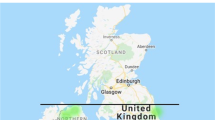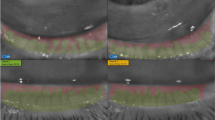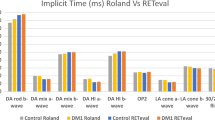Abstract
Purpose
To identify full-field electroretinographic (ffERG) biomarkers that differentiate active versus inactive birdshot chorioretinopathy (BSCR) and long-term efficacy of intravitreal versus systemic immunosuppression.
Methods
Patients with BSCR at Casey Eye Institute with ffERG between 1999–2019 were included (n = 29). A group of healthy patients was used as controls (n = 47). Patients with BSCR were categorized as active or inactive based on the uveitis specialist’s clinical assessment. Cross-sectional comparison of ffERG markers between active, inactive, and control patients was performed, in addition to rate analysis of ffERG metrics in BSCR eyes treated with either intravitreal fluocinolone acetonide 0.59 mg (IVFAI) or systemic immunomodulation (SI).
Results
Both active and inactive BSCR tended to have lower amplitude and slower timing than controls, but only 30 Hz flicker time (p < 0.001, p < 0.01) and dim scotopic b-wave amplitude (p < 0.001, p < 0.05) were significant. Timing for inactive BSCR was faster than active for bright scotopic a-wave (p < 0.01), photopic b-wave (p < 0.01), and 30 Hz flicker (p < 0.01). Eyes treated with SI showed improvement in dim scotopic b-wave amplitude compared to a decline for IVFAI (p < 0.05), whereas eyes treated with SI showed slower degradation of bright scotopic b-wave amplitude (p < 0.01). Conversely, eyes treated with IVFAI showed greater improvement in bright scotopic (p < 0.05) and photopic a-wave timing (p < 0.01).
Conclusions
Timing of 30 Hz flicker, bright scotopic a-wave, and photopic b-wave may be useful biomarkers for disease activity in BSCR. Moreover, both SI and IVFAI were effective in preserving retinal function to varying degrees.
This is a preview of subscription content, access via your institution
Access options
Subscribe to this journal
Receive 18 print issues and online access
$259.00 per year
only $14.39 per issue
Buy this article
- Purchase on SpringerLink
- Instant access to full article PDF
Prices may be subject to local taxes which are calculated during checkout
Similar content being viewed by others
Data availability
The data that support the findings of this study are available from the corresponding author upon reasonable request.
Change history
23 April 2025
The headings in tab. 2 and 5 have been updated due to inconsistency.
References
Shah KH, Levinson RD, Yu F, Goldhardt R, Gordon LK, Gonzales CR, et al. Birdshot chorioretinopathy. Surv Ophthalmol. 2005;50:519–41.
Khalil R, Petrushkin H, Rees A, Westcott M. The incidence, presenting clinical findings and treatment patterns of Birdshot Retinochoroiditis in a high-prevalence region: findings from Northern Ireland, England and Wales. Eye (Lond). 2023;37:2817–25.
Holder GE, Robson AG, Pavesio C, Graham EM. Electrophysiological characterisation and monitoring in the management of birdshot chorioretinopathy. Br J Ophthalmol. 2005;89:709–18.
Zacks DN, Samson CM, Loewenstein J, Foster CS. Electroretinograms as an indicator of disease activity in birdshot retinochoroidopathy. Graefes Arch Clin Exp Ophthalmol. 2002;240:601–7.
Tzekov R, Madow B. Visual electrodiagnostic testing in birdshot chorioretinopathy. J Ophthalmol. 2015;2015. 680215.
Sobrin L, Lam BL, Liu M, Feuer WJ, Davis JL. Electroretinographic monitoring in birdshot chorioretinopathy. Am J Ophthalmol. 2005;140:52–64.
Oh KT, Christmas NJ, Folk JC. Birdshot retinochoroiditis: long term follow-up of a chronically progressive disease. Am J Ophthalmol. 2002;133:622–9.
Cervantes-Castaneda RA, Gonzalez-Gonzalez LA, Cordero-Coma M, Yilmaz T, Foster CS. Combined therapy of cyclosporine A and mycophenolate mofetil for the treatment of birdshot retinochoroidopathy: a 12-month follow-up. Br J Ophthalmol. 2013;97:637–43.
Rush RB, Goldstein DA, Callanan DG, Meghpara B, Feuer WJ, Davis JL. Outcomes of birdshot chorioretinopathy treated with an intravitreal sustained-release fluocinolone acetonide-containing device. Am J Ophthalmol. 2011;151:630–6.
Weleber RG. The effect of age on human cone and rod ganzfeld electroretinograms. Invest Ophthalmol Vis Sci. 1981;20:392–9.
McCulloch DL, Marmor MF, Brigell MG, Hamilton R, Holder GE, Tzekov R, et al. ISCEV Standard for full-field clinical electroretinography (2015 update). Doc Ophthalmol. 2015;130:1–12.
Cao JH, Silpa-Archa S, Freitas-Neto CA, Foster CS. Birdshot chorioretinitis lesions on indocyanine green angiography as an indicator of disease activity. Retina. 2016;36:1751–7.
Zeidler I. The clinical electroretinogram. IX. The normal electroretinogram. Value of the b-potential in different age groups and its differenes in men and women. Acta Ophthalmol (Copenh). 1959;37:294–301.
Bush RA, Sieving PA. Inner retinal contributions to the primate photopic fast flicker electroretinogram. J Opt Soc Am A Opt Image Sci Vis. 1996;13:557–65.
Xu XJ, Xu J, Huang B, Livsey CT, Karwoski CJ. Comparison of pharmacological agents (aspartate vs. aminophosphonobutyric plus kynurenic acids) to block synaptic transmission from retinal photoreceptors in frog. Exp Eye Res. 1991;52:691–8.
Priem HA, De Rouck A, De Laey JJ, Bird AC. Electrophysiologic studies in birdshot chorioretinopathy. Am J Ophthalmol. 1988;106:430–6.
Hirose T, Katsumi O, Pruett RC, Sakaue H, Mehta M. Retinal function in birdshot retinochoroidopathy. Acta Ophthalmol (Copenh). 1991;69:327–37.
Gaudio PA, Kaye DB, Crawford JB. Histopathology of birdshot retinochoroidopathy. Br J Ophthalmol. 2002;86:1439–41.
Jaffe GJ, Martin D, Callanan D, Pearson PA, Levy B, Comstock T, et al. Fluocinolone acetonide implant (Retisert) for noninfectious posterior uveitis: thirty-four-week results of a multicenter randomized clinical study. Ophthalmology. 2006;113:1020–7.
Arcinue CA, Ceron OM, Foster CS. A comparison between the fluocinolone acetonide (Retisert) and dexamethasone (Ozurdex) intravitreal implants in uveitis. J Ocul Pharm Ther. 2013;29:501–7.
Mikhail M, Sallam A. Novel Intraocular Therapy in Non-infectious Uveitis of the Posterior Segment of the Eye. Med Hypothesis Discov Innov Ophthalmol. 2013;2:113–20.
Schwartz SG, Vaziri K, Kishor KS, Fortun J, Flynn HW Rates of Retinal Detachment following Retisert and Ozurdex Implants. Investigative Ophthalmology & Visual Science 2016 ARVO Annual Meeting. 2016;57.
Yang P, Foster CS. Interleukin 21, interleukin 23, and transforming growth factor beta1 in HLA-A29-associated birdshot retinochoroidopathy. Am J Ophthalmol. 2013;156:400–6.e2.
Zhong Z, Su G, Kijlstra A, Yang P. Activation of the interleukin-23/interleukin-17 signalling pathway in autoinflammatory and autoimmune uveitis. Prog Retin Eye Res. 2021;80. 100866.
Molins B, Mesquida M, Llorenc V, Sainz de la Maza M, Adan A. Elevated Serum Immune Mediators and Subclinical Inflammation in HLA-A29-associated Birdshot Chorioretinopathy. Ocul Immunol Inflamm. 2016;24:647–52.
Kuiper JJ, Mutis T, de Jager W, de Groot-Mijnes JD, Rothova A. Intraocular interleukin-17 and proinflammatory cytokines in HLA-A29-associated birdshot chorioretinopathy. Am J Ophthalmol. 2011;152:177–82.e1.
Ameri H, Naser M, Choudhury F, Rao NA. Electroretinogram and Visual Field Correlation in Birdshot Chorioretinopathy. Asia Pac J Ophthalmol (Philos). 2021;10:208–11.
Thorne JE, Jabs DA, Kedhar SR, Peters GB, Dunn JP. Loss of visual field among patients with birdshot chorioretinopathy. Am J Ophthalmol. 2008;145:23–8.
Funding
This work was supported by the National Institutes of Health (Bethesda, MD) P30 EY010572 core grant, the Malcolm M. Marquis, MD Endowed Fund for Innovation, and an unrestricted grant from Research to Prevent Blindness (New York, NY) to Casey Eye Institute, Oregon Health & Science University.
Author information
Authors and Affiliations
Contributions
CRR: study conceptualization, methodology, data collection, original draft; EW: statistical analysis; AA: data collection; SS: data collection; WT: methodology, data collection & curation, review and editing; DC: statistical analysis; RYC: study conceptualization, review and editing; RGW: data collection; JTR: data collection, review and editing; PL: data collection, review and editing; MEP: data collection, review and editing; EBS: data collection, review and editing; PY: study conceptualization, methodology, data collection and curation, review and editing, funding acquisition, supervision.
Corresponding author
Ethics declarations
Competing interests
The authors declare no competing interests.
Financial disclosures
There are no relevant financial disclosures.
Additional information
Publisher’s note Springer Nature remains neutral with regard to jurisdictional claims in published maps and institutional affiliations.
Supplementary information
Rights and permissions
Springer Nature or its licensor (e.g. a society or other partner) holds exclusive rights to this article under a publishing agreement with the author(s) or other rightsholder(s); author self-archiving of the accepted manuscript version of this article is solely governed by the terms of such publishing agreement and applicable law.
About this article
Cite this article
Rosenberg, C.R., White, E., Alsamarraie, A. et al. Electroretinography of disease activity and treatment response in birdshot chorioretinopathy. Eye 39, 1853–1859 (2025). https://doi.org/10.1038/s41433-025-03769-3
Received:
Revised:
Accepted:
Published:
Issue date:
DOI: https://doi.org/10.1038/s41433-025-03769-3



